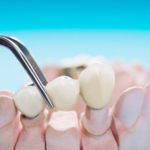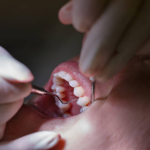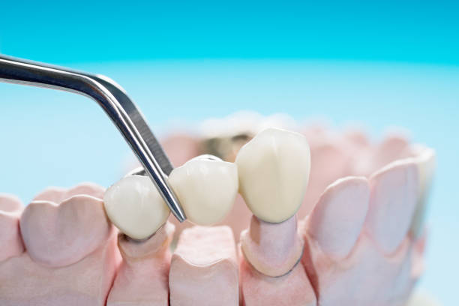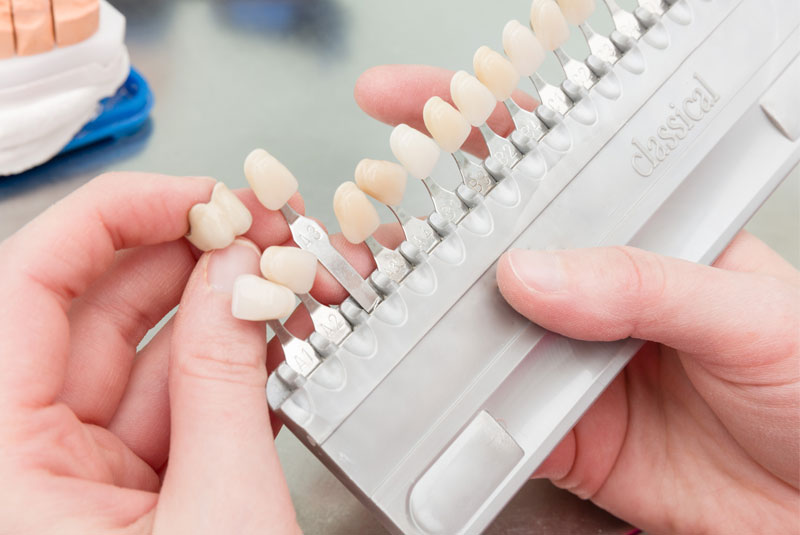A perfect smile is a highly desirable attribute that many of us strive to achieve. However, dental imperfections can often get in the way of a flawless smile.
Front tooth crowns and veneers are two popular cosmetic dental treatments that can help improve the appearance of front teeth. While both options serve the same purpose, they differ in material, procedure, and cost.
Choosing between these two options can be overwhelming and requires careful consideration of individual needs and preferences.
In this article, we’ll explore the differences between front tooth crowns and veneers and help you decide which option is right for you.
What Are Front Teeth Crowns?
Front tooth crowns, or dental caps, are custom-made, tooth-shaped caps covering the entire tooth.
They restore the shape, size, and strength of a tooth damaged due to decay, injury, or wear and tear. Crowns are also used to improve the appearance of teeth, especially front teeth that are discolored, misshapen, or have large fillings.
Crowns can be made from porcelain, ceramic, gold, and metal alloys.
Porcelain and ceramic crowns are popular options for front teeth, as they match the color and texture of natural teeth, providing a seamless and natural-looking smile. Gold and metal alloy crowns are more visible and less aesthetic but are known for their durability and strength.
The procedure for getting a crown typically involves two appointments. During the first appointment, the dentist will prepare the tooth by removing a small amount of enamel to make room for the crown.
They will then take impressions of the tooth and send them to a dental lab, where the crown will be custom-made to fit the tooth. A temporary crown will be placed on the tooth to protect it while the permanent crown is being made.
During the second appointment, the temporary crown will be removed, and the permanent crown will be cemented onto the tooth.
What Are Veneers?
Veneers are thin shells made of porcelain or composite resin placed on the tooth’s front surface to improve its appearance.
They correct minor dental imperfections such as discoloration, chipping, and gaps between teeth. Veneers are a popular cosmetic dental treatment for front teeth, as they can provide a quick and effective solution for achieving a natural-looking smile.
Porcelain veneers are the most common type used for front teeth, as they are highly durable and resistant to staining. Composite resin veneers are a more affordable option, but they are less durable and may require more frequent replacement.
The procedure for getting veneers typically involves three appointments. During the first appointment, the dentist will prepare the tooth by removing a small amount of enamel to make room for the veneer.
They will then take impressions of the tooth and send them to a dental lab, where the veneer will be custom-made to fit the tooth. A temporary veneer will be placed on the tooth to protect it while the permanent veneer is being made.
During the second appointment, the temporary veneer will be removed, and the permanent veneer will be placed on the tooth using a unique adhesive.
During the third appointment, the dentist will check the fit and appearance of the veneer and make any necessary adjustments.
Differences Between Front Teeth Crowns and Veneers
Front tooth crowns and veneers are both cosmetic dental treatments that can improve the appearance of front teeth. However, they differ in several ways, including:
Material
Crowns can be made from porcelain, ceramic, gold, and metal alloys, while veneers are made from porcelain or composite resin.
Procedure
Crowns require two appointments, while veneers require three appointments.
Amount of tooth preparation
Crowns require more tooth preparation than veneers, as more enamel needs to be removed to make room for the crown.
Durability
Crowns are more durable and can last up to 15 years, while veneers typically last between 5 and 10 years.
Cost
Crowns are generally more expensive than veneers, requiring more material and a more lengthy procedure.
Pros and Cons of Front Teeth Crowns
Front tooth crowns have several advantages and disadvantages that should be considered before deciding.
Pros
- It can be used to restore severely damaged teeth.
- Provides better protection and support for the tooth than veneers.
- It can be made from a variety of materials, including porcelain and ceramic, which provide a natural-looking appearance.
- And can last up to 15 years or more with proper care and maintenance.
Cons
- Requires more tooth preparation than veneers, which can lead to increased sensitivity and the risk of nerve damage.
- More expensive than veneers.
- It can be more visible and less aesthetic than veneers, especially if made from gold or metal alloys.
Pros and Cons of Veneers
Veneers also have several advantages and disadvantages that should be considered before deciding.
Pros
- It can improve the appearance of front teeth quickly and effectively.
- It requires less tooth preparation than crowns, which can lead to less sensitivity and a lower risk of nerve damage.
- It can be made from porcelain or composite resin, which provides a natural-looking appearance.
- It can last between 5 and 10 years with proper care and maintenance.
Cons
- It can only be used to correct minor dental imperfections.
- Provides less protection and support to the tooth than crowns.
- Composite resin veneers are less durable and may require more frequent replacement.
- Porcelain veneers are more expensive than composite resin veneers.
Factors to Consider When Choosing Between Front Teeth Crowns and Veneers
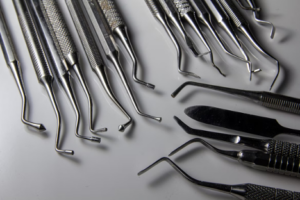
Choosing between front tooth crowns and veneers requires careful consideration of individual needs and preferences. Some factors to consider includes the following:
The extent of dental damage or imperfections
Crowns are a better option for restoring severely damaged teeth, while veneers are a better option for correcting minor dental imperfections.
The desired outcome
Crowns provide better protection and support to the tooth than veneers, while veneers provide a quick and effective solution for achieving a natural-looking smile.
Cost
Crowns are generally more expensive than veneers and may not be covered by dental insurance.
Durability
Crowns are more durable than veneers and can last up to 15 years or more, while veneers typically last between 5 and 10 years.
Material
Porcelain and ceramic crowns and veneers look natural, while gold and metal alloy crowns can be less aesthetic.
Maintenance and Durability of Front Teeth Crowns and Veneers
Maintaining good oral hygiene is essential for the longevity of front teeth crowns and veneers. Both options require regular brushing, flossing, routine dental checkups, and cleanings.
Crowns are more durable and resistant to wear and tear than veneers but can still be susceptible to damage from grinding or clenching of teeth. Wearing a mouthguard while sleeping can help protect the crown from damage.
Veneers are less durable than crowns and may require more frequent replacements. They are also more susceptible to staining from coffee, tea, and other dark-colored beverages.
Avoiding or limiting the consumption of these beverages and practicing good oral hygiene can help prolong the lifespan of veneers.
Visit Your Dentist at Tabor Dental Associates Now!
Quality and sophistication should not imply less relatability and personalization. At Tabor Dental Associates, we’ve built a clinic that gives patients the comprehensive, state-of-the-art care they want and deserve, along with the reliable small-town values they expect.
What may be surprising is that we accomplish all of this in a pleasant and relaxed setting. The fact that we offer high-quality dental care and have signed guitars in each patient room shows how much we care.
We have become one of the most esteemed and well-regarded dentists in Hendersonville, Tennessee, and the greater Nashville region by basing our business on professionalism, enthusiasm, expertise, and commitment.
Make an appointment now to see how we combine art, science, and trust with every patient.
Transform your smile and boost your confidence with Prepless Veneers, Smile Makeovers, and Dental Veneers. If you want to enhance your smile and correct imperfections, these cosmetic dentistry solutions may be just what you need.
But what exactly are Prepless Veneers? How do Smile Makeovers work? And what is it like to be a patient getting Dental Veneers? To learn more about these popular treatments, click on the links below:
“Dental Veneers, a Patient’s Story”
At our dental practice, we specialize in helping patients achieve the smile of their dreams. Whether you’re dealing with discolored, crooked, or chipped teeth, we can work with you to create a customized treatment plan that fits your unique needs and goals.
So why wait? Click on the links above to learn more about these transformative treatments.
Conclusion: Choosing the Best Option for Your Smile Makeover
Front tooth crowns and veneers are both effective cosmetic dental treatments that can improve the appearance of front teeth.
Choosing between these two options requires careful consideration of individual needs and preferences and consultation with a qualified and experienced dentist.
Factors such as the extent of dental damage or imperfections, the desired outcome, cost, durability, and material should be considered when deciding.
Remember that maintaining good oral hygiene is essential for the longevity of both front tooth crowns and veneers.
Regular brushing and flossing, as well as routine dental check-ups and cleanings, can help ensure the longevity of your smile makeover.



